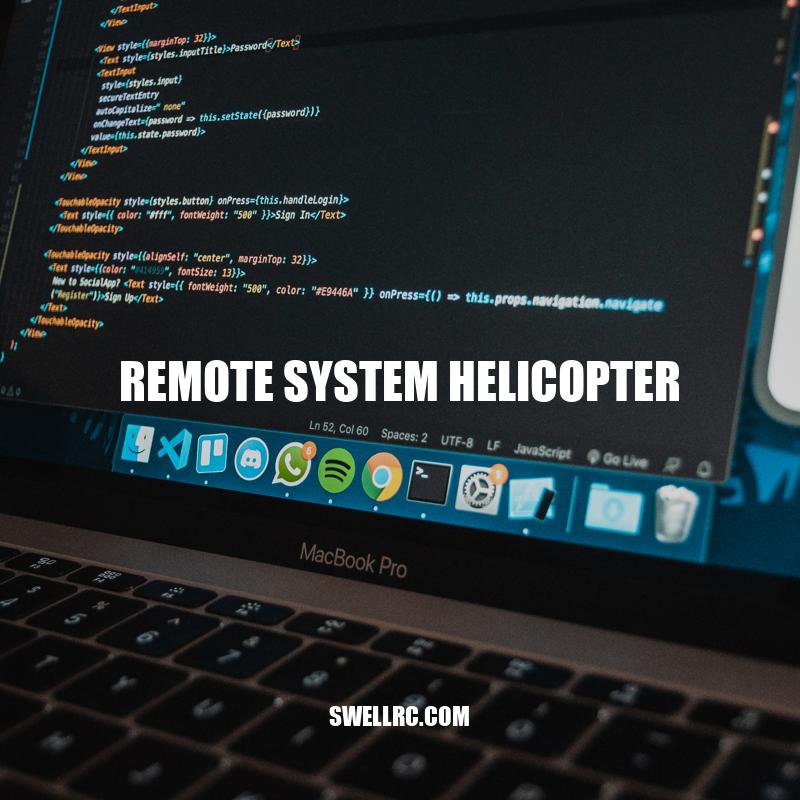Remote System Helicopter: Applications, Features, and Future
Remote system helicopters, also known as unmanned aerial vehicles (UAVs) or drones, have revolutionized the way we collect information, perform tasks, and conduct research in hard-to-reach areas. These advanced aerial vehicles are controlled remotely through a ground station and are equipped with sensors and cameras to capture high-quality images and videos. The development of remote system helicopters dates back to the early 20th century when unmanned aircraft were first used for military surveillance purposes. However, the rapid advancements in technology over the past few decades have led to the widespread use of these aircraft for various civilian applications. Today, remote system helicopters are used for a broad range of purposes, including aerial photography, delivery of goods, scientific research, and search and rescue operations. With increasing interest and investment in this technology, the future of remote system helicopters looks promising. Researchers are exploring innovative solutions to improve their operational efficiency and to find new and creative applications in various fields. In this article, we will delve into the architecture, features, applications, safety, regulations, and future possibilities of remote system helicopters.
Remote system helicopters have several key components that work together to create a stable and efficient flight. Here are some of the features that make them unique:
- The flight control system: This is one of the most critical components of a remote system helicopter. It consists of sensors, gyros, and a microcontroller that allows the aircraft to remain stable and navigate autonomously.
- Propulsion system: Remote system helicopters typically use electric brushless motors that are more efficient and have a longer lifespan than conventional brushed motors.
- Battery: The battery is the power source of the aircraft and determines how long the helicopter can stay in the air.
- Sensors: Remote system helicopters are equipped with a variety of sensors, including accelerometers, barometers, and magnetometers. These sensors detect changes in altitude, orientation, and positioning, which are essential for maintaining stability during flight.
- Camera: The cameras on remote system helicopters are an essential feature that allows them to capture high-quality images and videos from the air. The camera is typically mounted on a gimbal for smoother, more stable footage.
In addition to these features, remote system helicopters come in various types, such as quadcopters, hexacopters, and octocopters. Each type has its unique capabilities and features. If you’re looking to purchase a remote system helicopter for personal or commercial use, it’s essential to research the different types and features available. There are many websites that offer comprehensive reviews of the best remote system helicopters on the market, such as DroneRush and Dronethusiast.
What are the different types of remote system helicopters?
Helicopters are fascinating machines that have changed the way people explore and travel. As technology advances, one of the most significant technological advancements is the development of remote system helicopters. These machines are now ubiquitous in various industries, including military and aerial surveillance, aerial photography and videography, and recreational activity. Here are some of the different types of remote system helicopters used to cater to different needs.
1. Single Rotor Helicopters
Single rotor helicopters are the most common types of remote system helicopters used in the industry. They operate by rotating a single rotor blade, which is attached to the main rotor shaft. These remote system helicopters are often used by film crews and photographers because of their ability to capture high-quality aerial shots.
2. Multi-Rotor Helicopters
Multi-rotor remote system helicopters have two or more rotors. They are more stable than single rotor helicopters and can easily maneuver in tight spaces, making them ideal for indoor applications. They are commonly used in aerial surveys, search and rescue missions, and as delivery drones.
3. Tandem Rotor Helicopters
Tandem rotor helicopters have two rotors, one mounted in front of the other. They are known for their exceptional lifting capabilities, making them ideal for transporting heavy loads. These types of remote system helicopters are used in military operations and construction sites.
4. Co-Axial Rotor Helicopters
Co-axial rotor helicopters have two rotors mounted on top of each other, spinning in opposite directions. They offer excellent stability and are easy to control, making them perfect for beginner pilots. These remote system helicopters are commonly used for recreational purposes, aerial surveillance, and farming.
In conclusion, remote system helicopters have revolutionized the way people operate, reducing the need for manned aircraft, and improving operational efficiency. Different types of remote control helicopters cater to various industry needs, and understanding their differences can help you choose the right one for your specific application.
Applications of Remote System Helicopter
The versatility and efficiency of remote system helicopters have led to numerous applications in various fields. Here are some of the common applications of remote system helicopters:
- Aerial photography and videography: Remote system helicopters equipped with high-quality cameras are widely used for capturing aerial images and videos for different purposes such as news coverage, real estate, and tourism.
- Search and rescue operations: Remote system helicopters can access hard-to-reach areas and provide real-time visuals, which are crucial in rescue operations, especially in disaster-stricken areas.
- Delivery: Companies such as Amazon and UPS are actively testing drone delivery services in select regions to speed up deliveries and minimize costs.
- Survey and inspection: Remote system helicopters are useful in survey and inspection tasks that require visual data, such as monitoring infrastructure and crops, wildlife monitoring, and environmental studies.
Remote system helicopters are a relatively new technology that has evolved rapidly in the past decade. As a result, there are many innovative and exciting applications, both in development and currently in use. For example:
| Industry/Application | Examples |
|---|---|
| Agriculture | Field crop spraying, crop health monitoring |
| Construction | Site survey, material transport, aerial footage for marketing and promotion |
| Entertainment | Live events filming, theme park attractions |
| Emergency response | Disaster response, wildfire management |
As remote system helicopters continue to evolve, new and interesting applications will continue to emerge. If you’re interested in learning more about the applications of remote system helicopters, there are several industry websites such as Drone Life and sUAS News that regularly cover the latest developments in the field.
What are some examples of the applications of remote system helicopters in entertainment?
Remote system helicopters, also known as drones, have become increasingly popular in the entertainment industry, both in live performances and for film and photography. These versatile aircraft offer unique perspectives and angles that were once impossible to capture without expensive and complicated rigging.
One popular use of remote system helicopters in the entertainment world is for aerial cinematography. Drones are equipped with high-quality cameras, allowing filmmakers to capture sweeping shots of landscapes, cityscapes, and other environments that would be difficult or impossible for a traditional camera crew to reach. This technology has been used in a variety of films, from action-packed blockbusters to intimate documentaries.
In addition to film and television, drones have also become a common sight at live music events and festivals. Some artists use drones to capture footage of their performances from new angles, while others incorporate them into their show as part of the visual spectacle. Drones can also be used to light up the stage or to create stunning displays of synchronized movement.
Another application of drones in entertainment is for theme park attractions. In recent years, several popular theme parks have integrated drones into their shows and parades, creating dazzling displays of lights and movement that are sure to capture the attention of visitors young and old.
Overall, remote system helicopters are revolutionizing the way we capture and present entertainment. With their versatility and affordability, it’s no surprise that drones are becoming an increasingly popular tool for filmmakers, musicians, and other entertainers.
Safety and Regulations for Remote System Helicopter
As with any technology, safety and regulations are critical concerns. As for remote system helicopters, because they are flying aircraft, it is essential to maintain high safety standards and to follow the applicable regulations. Some of the safety concerns and regulations that apply to remote system helicopters include:
- Potential collisions: Remote system helicopters share the airspace with other vehicles, including manned aircraft, and avoiding collisions is critical. Some remote system helicopters are equipped with advanced sensors to detect and avoid other objects, and operators must always fly the helicopter in a safe and responsible manner.
- Regulatory compliance: Operators must ensure that they comply with FAA regulations for flying remote system helicopters. These regulations include restrictions on where and when the helicopter can fly, registration requirements, and the need for permits in certain circumstances.
- Training and certification: As with any profession, it is essential to obtain proper training and certification to operate a remote system helicopter safely. This training should cover topics such as flight safety, operation procedures, and emergency handling.
Safety and regulatory compliance matter in the world of remote system helicopters. If you’re interested in flying a remote system helicopter, it is essential to learn about the relevant regulations and guidelines. Several websites offer resources about safety, regulatory compliance, and training programs. A few examples include:
- FAA – the Federal Aviation Administration website provides information about regulations and guidance for flying remote system helicopters
- Drone Safety Aviation – a website dedicated to providing safety resources for remote system helicopter operators
- DARTdrones – a drone training and certification program provider that offers courses for remote system helicopter pilots
By following the safety standards and regulations, remote system helicopters can be used without creating hazards and keep their benefits for years to come.
‘What are some resources for learning about safety and regulatory compliance for remote system helicopters’?
If you are looking for resources to learn about safety and regulatory compliance for remote system helicopters, there are several places you can go to get reliable information.
One of the best places to start is with the Federal Aviation Administration (FAA). The FAA has a wealth of information on their website about regulations and safety guidelines for all types of aircraft, including remote system helicopters. They also have a section specifically dedicated to unmanned aircraft systems (UAS), which includes information on rules and regulations for commercial and recreational use, as well as safety guidelines and resources for pilots and operators.
Another great resource is the Academy of Model Aeronautics (AMA). The AMA is a non-profit organization that promotes the safe and responsible operation of model aircraft, including remote system helicopters. They offer a range of resources and educational programs for members, as well as safety guidelines and best practices for operating model aircraft.
If you are looking for more in-depth information on the technical aspects of remote system helicopters and their operation, you may want to consider joining a professional organization or attending a training program. The Association for Unmanned Vehicle Systems International (AUVSI) and the International Association of Machinists and Aerospace Workers (IAM) both offer resources and training programs for operators and technicians in the unmanned aircraft industry.
In addition to these resources, it is important to stay up-to-date on the latest research and developments in the field of remote system helicopters. Keeping abreast of new technologies, safety guidelines, and regulatory changes can help ensure that you are operating your remote system helicopter safely and in compliance with all relevant rules and regulations.
The Future of Remote System Helicopters
Looking ahead, the future of remote system helicopters is bright. As technology continues to evolve and advance, remote system helicopters will become even more sophisticated and capable of performing an increasing variety of missions. With the advent of 5G networks, remote system helicopters will be able to transmit real-time data from even the most remote areas. In addition, the growing use of artificial intelligence and machine learning algorithms will enable the development of highly autonomous remote system helicopters that can operate more efficiently.
In the future, remote system helicopters could be used for a range of exciting applications such as:
– Delivery of essential goods in emergency situations
– Inspection and maintenance of critical infrastructure such as offshore oil rigs, wind turbines, and power lines
– Environmental monitoring for disaster response, wildlife management, and climate change research.
Furthermore, remote system helicopters can play a critical role in the transportation sector, especially in urban areas where traffic congestion is increasingly problematic. Several companies are already exploring the potential of air taxis, which could launch a new era of transportation in the coming years.
In conclusion, as technology continues to advance, remote system helicopters will become increasingly integral to a broad range of industries. With the development of improved safety standards, regulatory guidelines, and increased training for operators, remote system helicopters will continue to revolutionize the way we gather information, transport goods, and perform a range of other vital functions. There’s no doubt that we will continue to see remote system helicopters play an essential role in society for many years to come.



